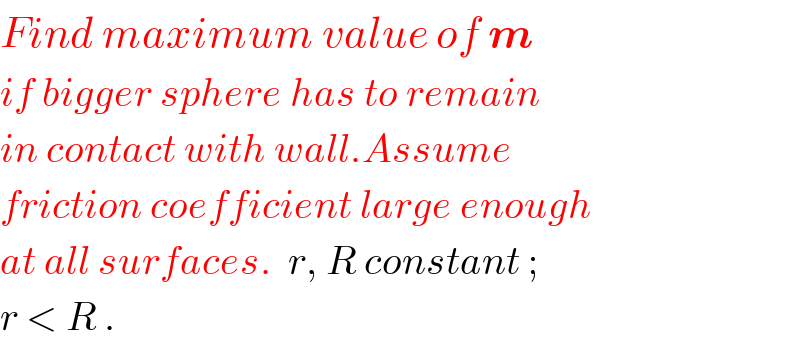
Question Number 29016 by ajfour last updated on 03/Feb/18

Commented by ajfour last updated on 03/Feb/18

$${Find}\:{maximum}\:{value}\:{of}\:\boldsymbol{{m}} \\ $$$${if}\:{bigger}\:{sphere}\:{has}\:{to}\:{remain} \\ $$$${in}\:{contact}\:{with}\:{wall}.{Assume} \\ $$$${friction}\:{coefficient}\:{large}\:{enough} \\ $$$${at}\:{all}\:{surfaces}.\:\:{r},\:{R}\:{constant}\:; \\ $$$${r}\:<\:{R}\:. \\ $$
Answered by ajfour last updated on 03/Feb/18

Commented by ajfour last updated on 03/Feb/18
![sin θ =((R−r)/(R+r)) , f_g =f and f=f_w considering zero torque on both spheres individually about their centres. f_g =N_w considering net horizontal force on system consisting of both spheres. so f_g =f_w =f=N_w eq.(A) (do keep in mind ) net horizontal force on system f_w +N_g =(M+m)g ⇒ f+N_g = (M+m)g ....(i) ΣF_x =0 for smaller sphere N_w +fcos θ=Nsin θ ⇒ f(1+cos θ)=Nsin θ ....(ii) ΣF_y =0 , so f_w +Ncos θ+fsin θ=mg ⇒ f(1+sin θ)+Ncos θ =mg ...(iii) ΣF_x =0 for larger sphere fcos θ+f_g = Nsin θ ⇒ f(1+cos θ) =Nsin θ [same as (i)] ΣF_y =0 , so fsin θ+Mg+Ncos θ = N_g Torque about corner of ground and wall gives: MgR+mgr+N_w [R+(R+r)cos θ] = N_g R .....(iv) we have unknowns f, m, N, N_g and eq.s (i) to (iv) using (ii) in (iii): N[((sin θ(1+sin θ))/(1+cos θ))+cos θ]=mg ⇒ N=((mg(1+cos 𝛉))/(1+cos 𝛉+sin 𝛉)) f = ((mgsin 𝛉)/(1+cos 𝛉+sin 𝛉)) =N_w N_g = (M+m)g−f using these in (iv): MgR+mgr+f[R+(R+r)cos θ] =(M+m)gR−fR ⇒ mgr+f[2R+(R+r)cos θ]−mgR =Mg(R−r) ((mgsin θ[2R+(R+r)cos θ])/(1+sin θcos θ))−mg(R−r) =Mg(R−r) m=((M(R−r))/([((sin θ[2R+(R+r)cos θ])/(1+sin θcos θ)) − (R−r)])) .](Q29057.png)
$$\mathrm{sin}\:\theta\:=\frac{{R}−{r}}{{R}+{r}}\:\:, \\ $$$${f}_{{g}} ={f}\:\:\:{and}\:\:\:{f}={f}_{{w}} \:\:{considering} \\ $$$${zero}\:{torque}\:{on}\:{both}\:{spheres} \\ $$$${individually}\:{about}\:{their}\:{centres}. \\ $$$$\:\:\:\:{f}_{{g}} ={N}_{{w}} \:\:\:\:{considering}\:{net}\: \\ $$$${horizontal}\:{force}\:{on}\:{system} \\ $$$${consisting}\:{of}\:{both}\:{spheres}. \\ $$$${so}\:\:\:\:\:\:\:\boldsymbol{{f}}_{\boldsymbol{{g}}} =\boldsymbol{{f}}_{\boldsymbol{{w}}} =\boldsymbol{{f}}=\boldsymbol{{N}}_{\boldsymbol{{w}}} \:\:\:\:\:\:\:{eq}.\left({A}\right) \\ $$$$\:\:\left({do}\:{keep}\:{in}\:{mind}\:\right) \\ $$$${net}\:{horizontal}\:{force}\:{on}\:{system} \\ $$$$\:\:\:{f}_{{w}} +{N}_{{g}} =\left({M}+{m}\right){g}\:\:\:\:\: \\ $$$$\Rightarrow\:\:\:\:\:{f}+{N}_{{g}} \:=\:\left({M}+{m}\right){g}\:\:\:....\left({i}\right) \\ $$$$\Sigma{F}_{{x}} =\mathrm{0}\:\:\:{for}\:{smaller}\:{sphere} \\ $$$$\:{N}_{{w}} +{f}\mathrm{cos}\:\theta={N}\mathrm{sin}\:\theta \\ $$$$\Rightarrow\:\:\:\:{f}\left(\mathrm{1}+\mathrm{cos}\:\theta\right)={N}\mathrm{sin}\:\theta\:\:\:....\left({ii}\right) \\ $$$$\Sigma{F}_{{y}} =\mathrm{0}\:\:,\:{so} \\ $$$$\:\:\:{f}_{{w}} +{N}\mathrm{cos}\:\theta+{f}\mathrm{sin}\:\theta={mg} \\ $$$$\Rightarrow\:{f}\left(\mathrm{1}+\mathrm{sin}\:\theta\right)+{N}\mathrm{cos}\:\theta\:={mg}\:\:...\left({iii}\right) \\ $$$$\Sigma{F}_{{x}} =\mathrm{0}\:\:\:{for}\:{larger}\:{sphere} \\ $$$${f}\mathrm{cos}\:\theta+{f}_{{g}} =\:{N}\mathrm{sin}\:\theta \\ $$$$\Rightarrow\:\:\:\:\:{f}\left(\mathrm{1}+\mathrm{cos}\:\theta\right)\:={N}\mathrm{sin}\:\theta\:\:\:\left[{same}\:{as}\:\left({i}\right)\right] \\ $$$$\Sigma{F}_{{y}} =\mathrm{0}\:,\:{so} \\ $$$${f}\mathrm{sin}\:\theta+{Mg}+{N}\mathrm{cos}\:\theta\:=\:{N}_{{g}} \\ $$$${Torque}\:{about}\:{corner}\:{of}\:{ground} \\ $$$${and}\:{wall}\:{gives}: \\ $$$${MgR}+{mgr}+{N}_{{w}} \left[{R}+\left({R}+{r}\right)\mathrm{cos}\:\theta\right] \\ $$$$\:\:\:\:\:\:\:\:\:\:\:\:\:\:\:\:\:\:=\:{N}_{{g}} {R}\:\:\:\:\:\:\:\:\:\:\:\:\:.....\left({iv}\right) \\ $$$${we}\:{have}\:{unknowns} \\ $$$$\:\:\:{f},\:{m},\:{N},\:{N}_{{g}} \:\:\:{and}\:{eq}.{s}\:\:\left({i}\right)\:{to}\:\left({iv}\right) \\ $$$${using}\:\left({ii}\right)\:{in}\:\left({iii}\right): \\ $$$$\:\:{N}\left[\frac{\mathrm{sin}\:\theta\left(\mathrm{1}+\mathrm{sin}\:\theta\right)}{\mathrm{1}+\mathrm{cos}\:\theta}+\mathrm{cos}\:\theta\right]={mg} \\ $$$$\Rightarrow\:\:\boldsymbol{{N}}=\frac{\boldsymbol{{mg}}\left(\mathrm{1}+\mathrm{cos}\:\boldsymbol{\theta}\right)}{\mathrm{1}+\mathrm{cos}\:\boldsymbol{\theta}+\mathrm{sin}\:\boldsymbol{\theta}} \\ $$$$\:\:\:\:\:\:\:\boldsymbol{{f}}\:=\:\frac{\boldsymbol{{mg}}\mathrm{sin}\:\boldsymbol{\theta}}{\mathrm{1}+\mathrm{cos}\:\boldsymbol{\theta}+\mathrm{sin}\:\boldsymbol{\theta}}\:\:\:=\boldsymbol{{N}}_{\boldsymbol{{w}}} \\ $$$$\:\:\:\:\:\:\:\boldsymbol{{N}}_{\boldsymbol{{g}}} =\:\left(\boldsymbol{{M}}+\boldsymbol{{m}}\right)\boldsymbol{{g}}−\boldsymbol{{f}} \\ $$$${using}\:{these}\:{in}\:\left({iv}\right): \\ $$$${MgR}+{mgr}+{f}\left[{R}+\left({R}+{r}\right)\mathrm{cos}\:\theta\right] \\ $$$$\:\:\:\:\:\:\:\:\:\:\:\:\:=\left({M}+{m}\right){gR}−{fR} \\ $$$$\Rightarrow\:{mgr}+{f}\left[\mathrm{2}{R}+\left({R}+{r}\right)\mathrm{cos}\:\theta\right]−{mgR} \\ $$$$\:\:\:\:\:={Mg}\left({R}−{r}\right) \\ $$$$\:\frac{{mg}\mathrm{sin}\:\theta\left[\mathrm{2}{R}+\left({R}+{r}\right)\mathrm{cos}\:\theta\right]}{\mathrm{1}+\mathrm{sin}\:\theta\mathrm{cos}\:\theta}−{mg}\left({R}−{r}\right) \\ $$$$\:\:\:\:\:\:\:\:\:\:\:\:\:\:\:\:\:\:\:\:\:\:\:\:\:\:\:\:\:\:\:\:\:\:\:\:\:\:\:\:\:\:={Mg}\left({R}−{r}\right) \\ $$$${m}=\frac{{M}\left({R}−{r}\right)}{\left[\frac{\mathrm{sin}\:\theta\left[\mathrm{2}{R}+\left({R}+{r}\right)\mathrm{cos}\:\theta\right]}{\mathrm{1}+\mathrm{sin}\:\theta\mathrm{cos}\:\theta}\:−\:\left({R}−{r}\right)\right]}\:\:. \\ $$
Commented by mrW2 last updated on 03/Feb/18

$${The}\:{forces}\:{and}\:{also}\:{their}\:{directions} \\ $$$${as}\:{displayed}\:{in}\:{the}\:{diagram}\:{are}\: \\ $$$${correct}.\:{I}\:{can}\:{follow}\:{your}\:{steps}\:{and} \\ $$$${they}\:{are}\:{correct}. \\ $$
Commented by ajfour last updated on 04/Feb/18

$${thank}\:\:{you}\:{Sir}. \\ $$
